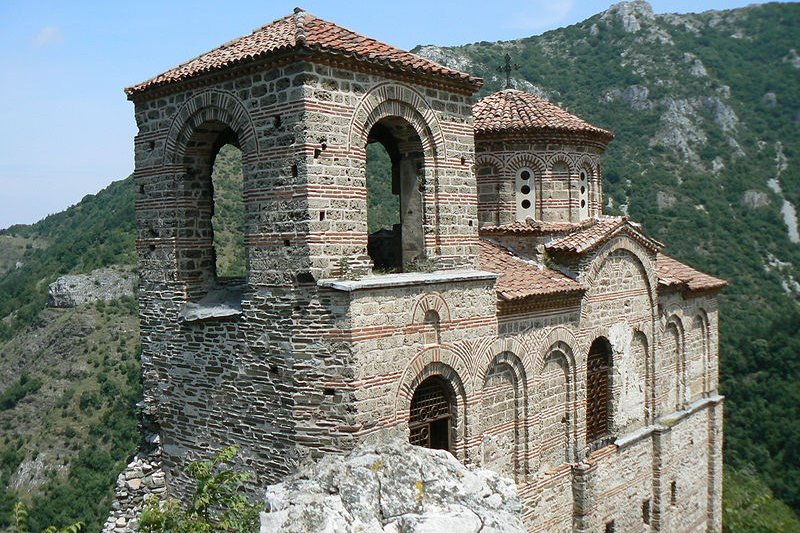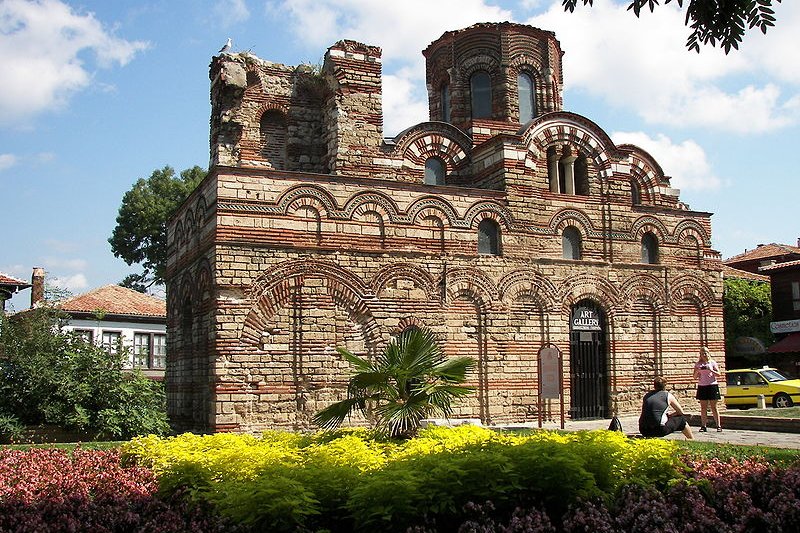 View from Vitosha to cloud-covered Sofia Valley, Bulgaria
View from Vitosha to cloud-covered Sofia Valley, BulgariaSource: https://commons.wikimedia.org/wiki/File:InversionSofiaValley.JPG
Author: Preslav

Places in Bulgaria on this website
View Bulgaria in a larger map
Bulgaria is a moderate size country in southeastern Europe. It has a coastline facing the Black Sea to the east, and share borders with Romania across the Danube to the north, Serbia and the Republic of Macedonia, to the west, and Greece and Turkey to the south.
Bulgaria covers 110,994 sq km (42,855 sq mi). It has a population of 7.5 million people. The capital and largest city is Sofia. Bulgaria is in the Eastern European Time zone, which is 2 hours ahead of Coordinated Universal Time, and three hours in summer. The traffic is driven on the right. The phone IDD code is +359. The official language of the country is Bulgarian, which is written in the Cyrillic alphabet as with Russian. The official currency is called the Lev (BGN).
 Asenova Fortress, Bulgaria
Asenova Fortress, BulgariaSource: https://commons.wikimedia.org/wiki/File:Asenova-fortress-2008-06-01-1.jpg
Author: Vassia Atanassova

In 2010, Bulgaria has a nominal GDP of $44.8 billion, equivalent to a per capita nominal GDP of $5,955. Its per capita GDP at purchasing power parity is $12,052. Since 1 January, 2007, Bulgaria is a member of the European Union.
Bulgaria experiences continental climate. Its winters are cold and damp with snow, especially in the highlands, while its summers are hot and humid. The coastal parts of Bulgaria enjoys temperate climate with mild autumns and cool winters. The summers here are warm and breezy.
Evidence of early human habitation in Bulgaria goes back to the 6th millennia BC. The First Bulgarian Empire was established in AD 681 with its capital in Pliska. In the 9th century Boris I the Baptist introduced Eastern Orthodox Christianity to Bulgaria, and with it, the Cyrillic alphabet.
Bulgaria was ruled by the Byzantine Empire at the beginning of the 11th century. It lasted a century and by 1185, was replaced by the Second Bulgarian Empire. In 1393 the Ottomans captured the capital of the Second Bulgarian Empire, Tarnovo, and began Ottoman rule which lasted for nearly five centuries. The defeat of the Ottomans in the Russo-Turkish War of 1877-78 brought an end of Ottoman rule, and ushered in the Third Bulgarian State.
 Nesebar Fortress, Bulgaria
Nesebar Fortress, BulgariaSource: https://commons.wikimedia.org/wiki/File:Bulgaria-Nesebar-04.JPG
Author: www.vacacionesbulgaria.com

The early decades of the 20th century were characterized by civil unrest, helping to establish the royal authoritarian dictatorship of Tsar Boris III. During the Second World War, it was aligned with the Axis forces, but managed to save its Jewish population by delaying compliance to German demands. The death of Boris III in 1943 brought political upheaval to Bulgaria. Communist uprising the following year abolished the monarchy, and in 1946, a Soviet-style people's republic was established.
The collapse of the Soviet Union may have induced the Bulgarian Communist Party to relinquish political monopoly on 10 November, 1989. The first free election took place on June, 1990, won by the Bulgarian Socialist Party, a moderate wing of the Communist Party. A new constitution was adopted in 1991, dismantling the socialist-style economy.
Bulgaria joined NATO in 2004 and the European Union in 2007. The country scores well in terms of freedom of speech and human rights records.
 Alexander Nevsky Cathedral, Sofia
Alexander Nevsky Cathedral, SofiaSource: https://commons.wikimedia.org/wiki/File:AlexanderNevskyCathedral-Sofia-6.jpg
Author: MrPanyGoff

Planning your visit to Bulgaria
Bulgaria is today a member of the Schengen Agreement, meaning visitors from the EU and EFTA countries only need to bring an approved ID to visit. As of January 2011, you do not need a visa for entering Bulgaria or any other Schengen member country if you are a citizen of Albania, Andorra, Antigua and Barbuda, Argentina, Australia, Bahamas, Barbados, Bosnia and Herzegovina, Brazil, Brunei, Canada, Chile, Costa Rica, Croatia, El Salvador, Guatemala, Honduras, Hong Kong, Israel, Japan, Macau, Malaysia, Mauritius, Mexico, Monaco, New Zealand, Nicaragua, Panama, Paraguay, Saint Kitts and Nevis, San Marino, Seychelles, Singapore, South Korea, Taiwan, United States, Uruguay, Vatican City, and Venezuela. Rock-hewn churches of Ivanovo, Bulgaria
Rock-hewn churches of Ivanovo, BulgariaSource: https://commons.wikimedia.org/wiki/File:Churches_of_Ivanovo_S.jpg
Author: Stoyan Chochkov

Flying in
The main international airport is the Sofit Airport (SOF), with flights from 25 airlines offering connections with destinations in western Europe. There are international airports in Varna, Bourgas and Plovdiv as well. It is also possible to take a train to Sofia from Kiev, Istanbul, Bucharest and Vienna.
Preparing Money for your trip to Bulgaria
The currency used in Bulgaria is the Bulgarian Lev (BGN).Planning your travel within Bulgaria
The national train operator is the Bulgarian State Railways (www.bdz.bg/index-en.php). You can check their English-language website for details of trains to visiting cities in the country.Recommended Travel Guidebook
My favorite travel guidebook for further reading in preparation of your trip is the Bulgaria Eyewitness Guide, because it follows a format that I find useful to users, not to mention I have also contributed to some of the titles in the Eyewitness series of guidebooks. Major Cities in Bulgaria
Major Cities in Bulgaria
 World Heritage Sites in Bulgaria
World Heritage Sites in Bulgaria
Bulgaria ratified the World Heritage Convention on 7 March, 1974. As of August 2010, it has seven Cultural World Heritage Sites and two Natural World Heritage Sites. Bulgaria also has fourteen properties presently listed to the World Heritage Tentative List.Bulgaria has served twice on the World Heritage Committee, in 1978-1983 and 1985-1991.
-
Cultural
- Boyana Church (1979)
- Madara Rider (1979)
- Rock-Hewn Churches of Ivanovo (1979)
- Thracian Tomb of Kazanlak (1979(
- Ancient City of Nessebar (1983)
- Rila Monastery (1983)
- Thracian Tomb of Sveshtari (1985)
Natural
- Pirin National Park (1983)
- Srebarna Nature Reserve (1983)
- Two neolithic dwellings with their interior and household furnishings and utensils completely preserved (1984)
- The Magoura cave with drawings from the bronze age (1984)
- The ancient town of Nicopolis ad Istrum (1984)
- The late ancient tomb of Silistra (1984)
- The Bachkovo Monastery (1984)
- The town of Melnik and the Rozhen Monastery (1984)
- The Rocks of Belogradchik (1984)
- The Vratsa Karst (1984)
- Central Balkan Park (1984)
- The Roussensky Lom National Park (1984)
- The Pobiti Kamani Natural Monument (1984)
- The Ancient Plovdiv (2004)
- Thracian Tomb with Wall Paintings beside Alexandrovo village (2004)
- Pirin National Park World Heritage Site (2006)
 Latest updates on Penang Travel Tips
Latest updates on Penang Travel Tips

Copyright © 2003-2025 Timothy Tye. All Rights Reserved.

 Go Back
Go Back